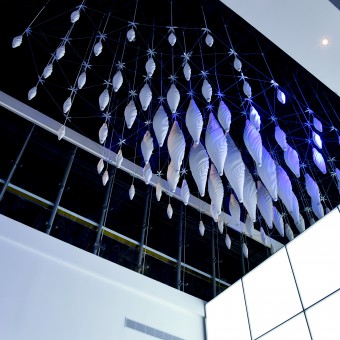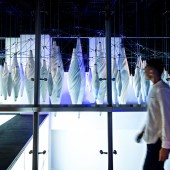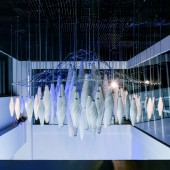Yinyun Ceramic 3D Print Art Installation by Fabcraft Design Lab |
Home > Winners > #101663 |
 |
|
||||
| DESIGN DETAILS | |||||
| DESIGN NAME: Yinyun PRIMARY FUNCTION: Ceramic 3D Print Art Installation INSPIRATION: The motivation of this project is to create an elegant art installation blending the science education atmosphere in this green energy exhibition hall. Inspired by the natural phenomenon of electromagnetic, which created non-uniformed field tensors in the space. To express this specific effect, an installation consisted of a large number of units were proposed, contrasting in form and pattern. This project also showcases Fabcraft design lab’s long-term interest in generative design and 3D printing technology. UNIQUE PROPERTIES / PROJECT DESCRIPTION: Yinyun is an art installation composed of 85 unique 3D printed ceramic units. Through generative design algorithm, the electric information was extracted and visualized on every unit, together creating a gradient effect. Ceramic 3D printing, with a mixture of recycled material, was then used to fabricate these units, at the same time, creating detailed surface relief which was indicated by this technique. None of the units is the same as others. OPERATION / FLOW / INTERACTION: The installation was designed to be viewed from different angles, at the same time, produce positive route guidance in the exhibition hall. A possible interaction can be created while visitors moving upstairs, changing from low angle to eye-level angle, they will observe an optical illusion caused by lights and textures. Moreover, the fluid surfaces are zoomed into a layered ceramic texture with rich 3D printing characteristics. PROJECT DURATION AND LOCATION: The project began at the end of 2018, and was completed in December 2019. Since then, it has been a permanent public art located in Taipower D/S ONE exhibition hall in Taipei, Taiwan. |
PRODUCTION / REALIZATION TECHNOLOGY: The project heavily relied on close cooperation among algorithm development, 3D printing, and material experiments. All designs were completed through several generative algorithms, including data processing, form generation, slicing, and Gcode output. Then our custom 3D printer with remote extrusion system was used to achieve such large sizes. The material was a mixture of white porcelain and coal ash recycled from power plant. SPECIFICATIONS / TECHNICAL PROPERTIES: Dimension(ceramic parts): L: 910cm, W: 360cm, H: 230cm TAGS: ceramic, 3D printing, generative, parametric design, digital fabrication, sustainable, recycle, coah ash, art installation, craft RESEARCH ABSTRACT: The goal of this project is to examine the relationship between traditional craft and modern techniques. As we developed a new shape language in digital space, it was completely originated from ceramic 3D printed texture. The traditional expertise in ceramics and modern digital fabrication skills were combined in real-world printing, together created pieces with rich craftsmanship, but can only be achieved by modern technique. CHALLENGE: In order to achieve large-scale and stable printing, we developed our custom extrusion system and slicing program, testing it back and forth between digital and physical space, which took nearly half of the time for this project. The material factors were carefully taken into consideration, including ceramic ratio, viscosity, temperature, humidity, since a 3D printer can't be dynamically adjusted as human hands during production. The shrinkage after firing also increased the difficulty of assembly. ADDED DATE: 2020-02-27 10:48:26 TEAM MEMBERS (5) : Art Director: Kamm, Kai-Yu, Designer: Liu, Zhao-Wei, Mechanism Design: Chen, Po-Yen, Ceramic Craftsman: Lu, Tzu-Yi and Ceramic Assistant: Xie, Yun-Chen IMAGE CREDITS: Image #1: Fabcraft Design Lab Image #2: Cogitoimage International Co., Ltd. Image #3: Fabcraft Design Lab Image #4: Fabcraft Design Lab Image #5: Fabcraft Design Lab |
||||
| Visit the following page to learn more: http://dsone.taipower.com.tw/space_galle |
|||||
| AWARD DETAILS | |
 |
Yinyun Ceramic 3d Print Art Installation by Fabcraft Design Lab is Winner in 3D Printed Forms and Products Design Category, 2019 - 2020.· Read the interview with designer Fabcraft Design Lab for design Yinyun here.· Press Members: Login or Register to request an exclusive interview with Fabcraft Design Lab. · Click here to register inorder to view the profile and other works by Fabcraft Design Lab. |
| SOCIAL |
| + Add to Likes / Favorites | Send to My Email | Comment | Testimonials | View Press-Release | Press Kit |
Did you like Fabcraft Design Lab's 3D Printing Design?
You will most likely enjoy other award winning 3d printing design as well.
Click here to view more Award Winning 3D Printing Design.








